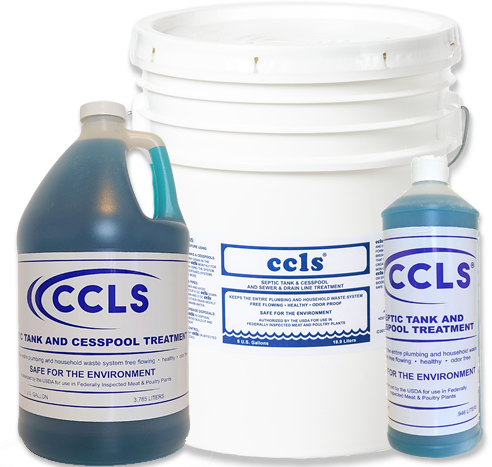Cape Cod Biochemical Company and Septic Contractors, Partners Since 1976

CCLS® SEPTIC TANK AND CESSPOOL TREATMENT
PURPOSES:
USES:
SUGGESTED APPLICATION AREAS:
PRODUCT COMPOSITION:
Liquid bacteria/enzyme formulation containing enzyme-producing bacteria to break down and digest protein, starch, fats, oils, grease, carbohydrates, detergents, and most organic waste.
APPEARANCE:
- Color: blue/green
- Specific gravity: 1 where water = 1
- Odor: Fermentation: not objectionable
- Packaging: 12x1 quarts :: 4x1 gallons :: 5 gallon pail
CONDITIONS FOR USE:
- Performs best in pH range 6.0-9.0
- Best temp range is 55°-100° F.
- Expect limited activity below 40° F
HOW IT WORKS:
The bacteria present produce enzymes that break down organic solid materials into food for bacteria. The bacteria digest this material and use the food to multiply and produce enzymes. This cycle continues until the waste has been completely digested, leaving the area free of solids, free-flowing, and odor-free.
ADVANTAGES:
CCLS® is formulated from naturally-occurring organisms. It needs no mixing. It is non-toxic, non-hazardous, non-corrosive, non-combustible. It emits no odors or harmful fumes. It will not harm the skin. It will not harm humans or pets, although not intended for human consumption. CCLS® contains no acids, caustics, chloride, or volatile organic compounds. CCLS® is biodegradable, is safe for environment, and is completely safe to store and use in the home when used according to directions.
NOTES: Store in cool, dry place. Do not expose to temperature exceeding 1200F for more than 8 hours. CCLS® is protected against freezing to 00F. It will survive three full freeze/thaw cycles with no damage to the organisms. However, it is not recommended that CCLS® be frozen, as it may burst the package. Flush all dosages with luke warm water. When treating multi-story buildings, treat lower floors first and work up. This will avoid clogging from above. For best results, use CCLS® according to planned maintenance schedule.
Apply dosage prior to period of lowest flow for maximum retention time.
Do not use in conjunction with bleach, disinfectants, or harsh drain cleaning as these will inactivate the bacterial activity of CCLS®.
APPLICATIONS: (see label for recommended dosages)
FOR SEPTIC TANKS AND CESSPOOLS: If septic tanks and cesspools are not properly maintained they will fill up with solids, they will clog the soil absorption areas, they will contaminate the soil, and they will become health hazards and burdensome expense. Apply CCLS® at least monthly in the home to maintain bacterial balance in the septic tank or cesspool. Older, overtaxed, or neglected systems may require a shock dosage to create high bacteria level.
DIRECTIONS: Shake well before using.
FOR SEPTIC TANKS & CESSPOOLS: Distribute 8 oz. CCLS® weekly OR 32 oz. monthly among all drains in the house.
For older or overtaxed septic tanks and cesspools, distribute 16 oz. weekly among all drains in the house.
SAFE FOR GARBAGE DISPOSAL: Apply 2 oz. CCLS® weekly directly to disposal and other drains to avoid buildup and odor.
FOR ODOR CONTROL: Check to make sure area is colorfast before applying. Dab or spray CCLS® directly on affected area as needed.
CCLS® contains natural bacteria and enzymes specifically formulated to biologically break down the organic build-up that can clog waste systems and create odors. CCLS® is non-toxic, non combustible, non-corrosive. CCLS® contains no caustics, acids, or EPA priority pollutants. It is biodegradable and completely safe to store and use in the home.
Not intended for human consumption. Avoid contact with eyes. Keep out of the reach of children
WHY HAS CCLS® BEEN #1 SINCE 1976? READ OUR CUSTOMER REVIEWS
CCLS® Approvals:
View the Florida Department of Health Approval PDF
View the County of Suffolk Approval PDF
View the Connecticut Department of Environmental Protection Approval PDF
View the Massachusetts Department of Environmental Protection Approval PDF
DID YOU
KNOW?

What Everyone Should Know About Septic Tank Systems
The proper operation of the septic system is essential to public and private health, to property values, and to the environment.
Learn More
